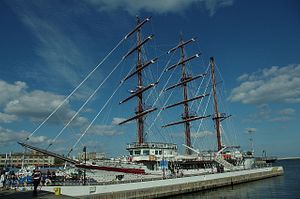Over the weekend, a Vietnamese naval vessel left for a voyage to Thailand and Cambodia. Though the trip is just the latest in a series of regular journeys, it has nonetheless put the spotlight on the evolving shape of the Southeast Asian state’s maritime diplomacy with regional states.
As I have noted previously in these pages, though not without its limitations, Vietnam has nonetheless built one of the more capable navies among Southeast Asian states over the years as it seeks to both secure its own interests while also engaging more with other states in the maritime domain (See: “Why a First US Aircraft Carrier Vietnam Visit Matters”).
A relatively recent addition to the Vietnam People’s Navy (VPN) has been the Le Quy Don (classified as Sailing Ship 286). Named after an 18th century Vietnamese philosopher and built in Poland, it was first commissioned into the VPN in March 2016 and billed by Vietnam as one of the world’s most modern sailing ships.
Le Quy Don has gradually been participating in a set of naval training activities and external missions at sea. Indeed, as an example, just in late March, it had departed for exchanges with the navies of Brunei, China, and the Philippines. The crew included senior students from the Naval Academy as part of their long distance training and exchanges at sea.
On April 15, the Vietnam Naval Academy officially deployed Le Quy Don for exercises and exchanges with the navies of Thailand and Cambodia. The sailing ship, which had a crew comprised of cadets and commanders from the Vietnam Naval Academy as well as representatives from the VPN, departed Nha Trang port for the two neighboring Southeast Asian countries.
Few specifics were disclosed about the exact activities of the mission. But it was expected to include a field training exercise at sea as well as exchanges with the Thai and Cambodian naval forces. The focus on Thailand and Cambodia for such missions is unsurprising given the fellow Southeast Asian states’ proximity to Vietnam and the prominent role given to neighbors in Hanoi’s maritime diplomacy.
According to Vietnam’s defense ministry, Senior Colonel Nguyen Duc Nam, the deputy director of the Vietnam Naval Academy and the head of the mission, said that the mission was to enhance friendship, trust, and mutual understanding between the three navies, promote exchanges among naval forces, and facilitate the improvement of capabilities and skills to confront challenges.

































